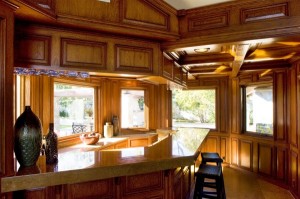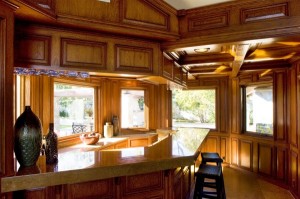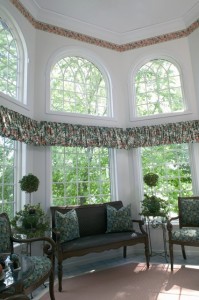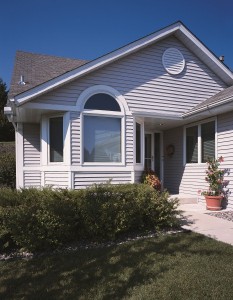Window Replacements | Window Treatments
Window Styles Comparison: Picture, Specialty, and Transom
June 10th, 2013 | 4 min. read
By Jenica Lee
Get weekly updates with the most recent articles and videos from Southwest Exteriors.
Subscribe
Whenever we meet with homeowners who are considering replacement windows for their home, a big part of the decision involves the styles of window they want.
Many people are unfamiliar with the options available to them in regards to window styles, so we like to educate them on the benefits and disadvantages of each kind to help them make the best decision for their home. In this series of comparing different window styles, we’ve already covered Double Hung vs Gliding Windows and Awning vs Casement Windows. Today, we’ll talk about different kinds of fixed windows (inoperable): Picture, Specialty, and Transom Windows.
Picture Windows
 A Picture Window doesn’t open or close, but instead really frames the view that you have outside your home with a nice picture frame look around the edge. The beautiful unobstructed view of the outdoors is very appealing in a sunroom or large living area. If a good quality window is chosen where you don't see exposed screw heads or sharp-angled aluminum framing, the picture window can really complement any view you have outside of your home. Because it is not an operable window, it is also the most energy efficient window of any other window option that you can put inside your wall. No hardware or other mechanics for opening and closing the window also cuts down on the cost of the window compared to other styles.
A Picture Window doesn’t open or close, but instead really frames the view that you have outside your home with a nice picture frame look around the edge. The beautiful unobstructed view of the outdoors is very appealing in a sunroom or large living area. If a good quality window is chosen where you don't see exposed screw heads or sharp-angled aluminum framing, the picture window can really complement any view you have outside of your home. Because it is not an operable window, it is also the most energy efficient window of any other window option that you can put inside your wall. No hardware or other mechanics for opening and closing the window also cuts down on the cost of the window compared to other styles.
The trend here in South Texas is that people want picture windows wherever they can, because of the unobstructed view, lower cost, and energy efficiency. Unfortunately, the downside to an inoperable window is that building egress code prohibits picture windows in bedrooms and home offices that don’t have any other access to outside. If you have views outside of your home that you would like to enjoy more often, then the picture window is a great solution as long as you do not need to open that particular window.
What is the Largest Home Window Type?
Picture windows can be the largest in a home because they are designed to be fixed windows that do not open or close. This means that they do not require any additional hardware or framing to accommodate the movement of the window sash, which can limit their size.
Because picture windows are fixed in place, they can be manufactured in very large sizes, providing unobstructed views and allowing more natural light into a room. In fact, picture windows are often used in modern and contemporary homes to create a seamless transition between indoor and outdoor living spaces, with expansive views of the surrounding landscape.
However, it's worth noting that larger windows can also be more expensive to install and may require additional structural support to ensure that they are properly secured and sealed. It's always a good idea to consult with a professional contractor or window installer to determine the best type and size of windows for your home based on your specific needs and budget.
Specialty and Transom Windows
 A specialty window come in a shape other than the typical rectangle, like pentagons, circles, or semi-circles. These are also fixed windows and create a very nice accent look in living areas. A transom window refers to a small window above a door or other larger window. In historical homes, you will often see transom windows that actually open and close like awning windows, used for ventilation before the days of air conditioning. Nowadays, transom windows are typically inoperable and used merely for decoration and adding more natural light to the room. They can be a rectangle shape or a specialty shape like a semi-circle.
A specialty window come in a shape other than the typical rectangle, like pentagons, circles, or semi-circles. These are also fixed windows and create a very nice accent look in living areas. A transom window refers to a small window above a door or other larger window. In historical homes, you will often see transom windows that actually open and close like awning windows, used for ventilation before the days of air conditioning. Nowadays, transom windows are typically inoperable and used merely for decoration and adding more natural light to the room. They can be a rectangle shape or a specialty shape like a semi-circle. 
As fixed windows, these have the same benefits and disadvantages as a normal picture window, although the unique shape often costs more than a comparably sized rectangular picture window. Their atypical design makes them a rare find in homes, but for those of you who do have specialty or transom windows, I think they always add a nice touch to the aesthetics of your home.
Our final article in this series on comparing different window styles will be the ones with an arched look: Bay and Bow Windows. You can also go back and check out the other articles we’ve done so far: Double Hung vs Gliding Windows and Awning vs Casement Windows. We hope they give you some valuable information for choosing the right window styles for your home. If you have any further questions, don’t hesitate to contact us directly.
